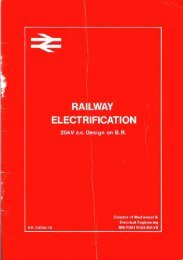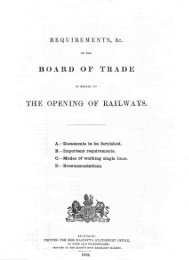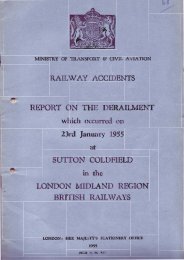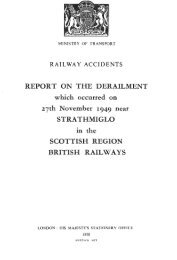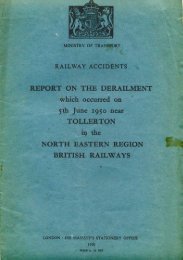R A I LT R AC K - The Railways Archive
R A I LT R AC K - The Railways Archive
R A I LT R AC K - The Railways Archive
You also want an ePaper? Increase the reach of your titles
YUMPU automatically turns print PDFs into web optimized ePapers that Google loves.
Route characteristics<br />
D E S C R I P T I O N <strong>The</strong> Ayr–Stranraer route is primarily single track with passing<br />
loops. This is a passenger route providing connections with the ferry to Northern<br />
Ireland as well as an essential local service. Coal traffic runs over the northern<br />
section between Ayr and Dalrymple Junction. In contrast, the Kilmarnock–Carlisle<br />
Line is double track as far as Annan. This is a busy, mixed traffic line with very<br />
high and increasing levels of freight traffic, mainly coal en route to power stations<br />
in England, from local open-cast sites and imported via Clydeport’s Hunterston<br />
Terminal. <strong>The</strong> line from Kilmarnock to Gretna Junction also acts as a diversionary<br />
route for WCML. <strong>The</strong> route is controlled from 14 signal boxes and has<br />
maximum linespeeds from 50mph to 80mph.<br />
BOTTLENECK ANALYSIS <strong>The</strong> Kilmarnock to Gretna Junction route has<br />
several interlinked restrictions on capacity, which together create bottlenecks<br />
identified in the 1998 NMS.<br />
Route vision<br />
<strong>The</strong> route provides links between smaller towns and larger conurbations and<br />
forms part of the Anglo–Scottish and Ireland–Scottish transport corridors. Our<br />
analysis predicts further significant increases of Anglo–Scottish freight trains, while<br />
other markets will continue to grow.<br />
Our vision for the route is one of a very busy rural railway with a significant<br />
requirement for freight train movements. We will provide the additional train<br />
paths and the new infrastructure to support them by providing additional loops<br />
and crossovers between Gretna and Kilmarnock. <strong>The</strong> existing infrastructure will<br />
be improved to allow larger and heavier trains. <strong>The</strong> route makes an important<br />
contribution to the economic growth of South West Scotland with its important<br />
ferry services.<br />
Route development and customer requirements<br />
ScotRail is primarily seeking to maintain and improve performance. <strong>The</strong>y are<br />
concerned that increased numbers of slower freight trains do not impede the<br />
movement of scheduled passenger trains. Dedicated freight train paths and the<br />
addition of a loop between Dumfries and New Cumnock will increase the<br />
capacity and maintain ScotRail’s performance. ScotRail is satisfied with the current<br />
track quality. <strong>The</strong>y are also keen that facilities at stations are improved.<br />
EWS and D R S require the provision to operate more trains with more flexibl e<br />
pathing arrangements between Carlisle and Kilmarnock. EWS also desires<br />
i m p r oved access to operate larg e r, heavier and longer trains. Both EWS and their<br />
<strong>The</strong> 125km route has a 13km single-line section, no passing loops, and long<br />
signalling sections which restrict train movements to a maximum of three per<br />
hour in each direction and 16–20 hours of operation per day.<br />
<strong>The</strong> recent growth in freight train movements means that most of the<br />
route’s capacity has been used.<br />
To accommodate predicted growth in freight train movements, we have<br />
already increased the opening hours of the route, as well as introducing<br />
dedicated paths for freight train services to maintain the high-punctuality<br />
standards required by ScotRail. During 1999/2000 we will provide a passing loop<br />
facility, which will provide capacity for predicted train movements. If, however,<br />
these continue to expand above the predicted level, we will undertake a series of<br />
incremental enhancement schemes.<br />
Our vision for passenger traffic is that it will grow, but that most of this growth<br />
will be accommodated. We are supporting this growth by providing better<br />
station facilities, and infrastructure works to provide improved reliability and<br />
performance.<br />
We see the Ireland–Scottish Route as vital for the economy of Stranraer.<br />
We will work in partnership with our customers and the local authorities to<br />
develop, expand and improve both passenger and freight business with the<br />
objective of benefiting the community and the environment by encouraging the<br />
transfer from road to rail.<br />
c u s t o m e rs are seeking to reopen disused sidings and provide suitable loading and<br />
unloading facilities. In part n e rship with EWS, we are curr e n t ly inve s t i g a t i n g<br />
extensions to loops and improved operation of the Knockshinnoch bra n c h ,<br />
together with sidings at Girvan, Stra n raer and in the New Cummock area.<br />
Local authorities want to see the facilities at stations improved as well as a<br />
faster and a more frequent level of services. This is particularly relevant at<br />
Stranraer, where the local authority is anxious to retain and expand rail links with<br />
the sea crossing to Belfast. A key issue in this area is connections from remote<br />
rural areas with major towns and long-distance services.<br />
311



